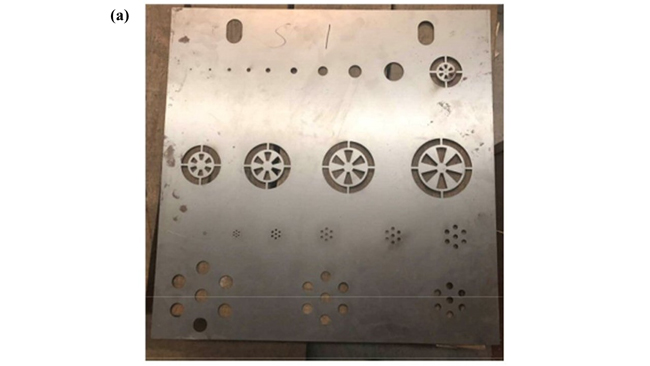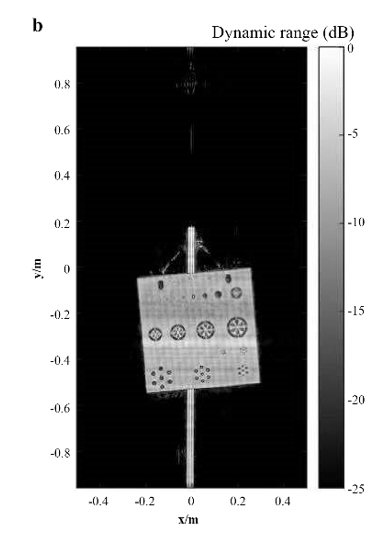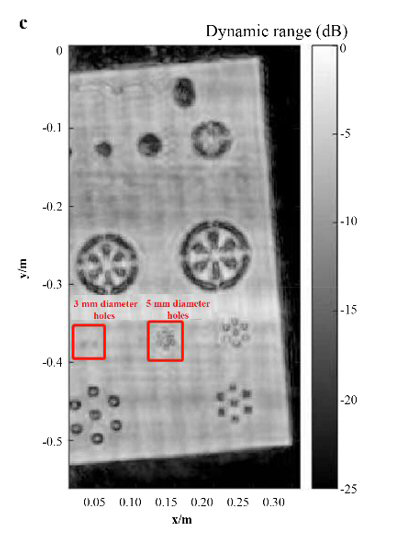Figure 15 is a block diagram of the antenna and distribution network. The fabricated prototype is shown in Figure 16. Based on the relationship between the system receive power and the detection distance in the system link analysis, the test distance is determined to be 0.35 m. The radiant flux of the mmWave equipment is one thousandth of the radiant flux of mobile phones.

Figure 15 Block diagram of the antenna and distribution network.

Figure 16 Prototype mmWave antenna and distribution network.
Based on the uniform distribution error analysis of the array elements, the processing precision of the array elements and the motion precision of the scanning frame are controlled to 0.2*dx. The linearity of the signal source is better than 5*e−4.
IMAGE ANALYSIS
The prototype system is first tested by determining the its ability to image objects on a test plate (see Figure 17) as compared with optical images. Figure 17a shows the optical images. Figure 17b shows the MMW images. The expanded view (see Figure 17c) shows distinct 5 mm round holes in the test plate and even a blurry image of 3 mm round holes.
Next, a human body is scanned (see Figure 18). These two images (Figures 18a and b) are from the same array, with the same processing accuracy, linearity and spectral error. The difference is motion accuracy. Figure 18b is the result of higher motion accuracy in the mechanical frame. It shows a vivid outline of the human body, including smooth muscle lines and 10 fingers, with a mobile phone visible in the hip pocket.



Figure 17 Test plate images: optical (a), mmWave image (b) and close-up of mmWave image (c).


Figure 18 Human body images: coarse motion accuracy (a) and fine motion accuracy (b).
CONCLUSIONS
A high-performance security check MMW imaging system for detection of objects on the human body is described. The results show suitable sensitivity and resolution at a conventional detection distance between 0 and 0.5 m. Through analysis and simulation, the distribution error of antenna array and the linearity of signal emitter minimize ISLRs. An optimized prototype demonstrates imaging with a resolution approaching 5 mm.
References
- 1. H. D. Collins, D. L. McMakin, T. E. Hall and R. P. Gribble, “Real-Time Holographic Surveillance System,” U.S. Patent 5 455 590, October 3, 1995.
- 2. C. Zech, A. Hülsmann, I. Kallfass and A. Tessmann, “Active Millimeter-Wave Imaging System for Material Analysis and Object Detection,” Proceedings of SPIE – the International Society for Optics and Photonics, October 2011.
- 3. D. Sheen, D. Mcmakin and T. Hall, “Near-Field Three-Dimensional Radar Imaging Techniques and Applications,” Applied Optics, Vol. 49, No. 19, 2010, pp. E83-E93.
- 4. R. Appleby, D. A. Robertson and D. Wikner, “Millimeter Wave Imaging: a Historical Review,” SPIE Defense + Security Conference Proceedings, May 2017.
- 5. J. Gao, Y. Qin, B. Deng, H. Wang and X. Li, “A Novel Method for 3-D Millimeter-Wave Holographic Reconstruction Based on Frequency Interferometry Techniques,” IEEE Transaction on Microwave Theory and Techniques, Vol. 66, No. 3, March 2018, pp. 1579-1596.
- 6. Z. Wang, T. Chang and H. -L. Cui, “Review of Active Millimeter Wave Imaging Techniques for Personnel Security Screening,” IEEE Access, Vol. 7, October 2019, pp. 148336-148350.
- 7. S. S. Ahmed, “Microwave Imaging in Security - Two Decades of Innovation,” IEEE Journal of Microwaves, Vol. 1, No. 1, January 2021, pp. 191-201.
- 8. Z. Zou, K. Chen, Z. Shi, Y. Guo and J. Ye, “Object Detection in 20 Years: A Survey,” Proceedings of the IEEE, Vol. 111, No. 3, March 2023, pp. 257-276.
- 9. S. Wu, H. Wang, C. Li, X. Liu and G. Fang, “A Modified Omega-K Algorithm for Near-Field Single-Frequency MIMO-Arc-Array-Based Azimuth Imaging,” IEEE Transactions on Antennas and Propagation, Vol. 69, No. 8, August 2021, pp. 4909-4922.
- 10. D. M. Sheen, D. L. McMakin and T. E. Hall, “Three-Dimensional Millimeter-Wave Imaging for Concealed Weapon Detection,” IEEE Transactions on Microwave Theory and Techniques, Vol. 49, No. 9, September 2001, pp. 581-1592.
- 11. R. Appleby and R. N. Anderton, Millimeter-Wave and Submillimeter-Wave Imaging for Security and Surveillance,” Proceedings of the IEEE, Vol. 95, No. 8, August 2007, 1683-1690.
- 12. S. Yeom, D. -S. Lee, H. Lee H, J. -Y Son and V. P. Gushin, “Distance Estimation of Concealed Objects with Stereoscopic Passive Millimeter-Wave Imaging,” Progress in Electromagnetics Research Letters, Vol. 115, 2011, pp. 399-407.
- 13. D. M. Sheen, D. L. McMakin, H. D. Collins and T. E. Hall, “Near-Field Millimeter-Wave Imaging for Weapon Detection,” Proceedings of SPIE –the International Society for Optics and Photonics, November 1992.
- 14. P. E. Keller, D. L. McMakin, D. M. Sheen, A. D. McKinnon and J. W. Summet, “Privacy Algorithm for Cylindrical Holographic Weapons Surveillance System,” IEEE Aerospace and Electronic Systems Magazine, Vol. 15, No. 2, February 2000, pp. 17-24.
- 15. D. L. McMakin, D. M. Sheen, J. W. Griffin and W. M. Lechelt, “Extremely High-Frequency Holographic Radar Imaging of Personnel and Mail,” Proceedings of SPIE – the International Society for Optics and Photonics, Proceedings of SPIE – the International Society for Optics and Photonics, Vol. 6201, May 2006.
- 16. D. L. McMakin, D. M. Sheen, T. E. Hall, M. O. Kennedy and H. P. Foote, Biometric Identification Using Holographic Radar Imaging Techniques,” Proceedings of SPIE – the International Society for Optics and Photonics, Vol. 6538, No. 1, April 2007.
- 17. N. C. Currie, F. J. Demma, D. D. Ferris Jr., R. W. McMillan and M. C. Wicks, “ARPA/NIJ/Rome Laboratory Concealed Weapon Detection Program: an Overview,” Proceedings of SPIE – the International Society for Optics and Photonics, Vol. 2755, June 1996.
- 18. M. C. Kemp, “Millimetre Wave and Terahertz Technology for the Detection of Concealed Threats: a Review,” Joint 32nd International Conference on Infrared and Millimeter Waves and the 15th International Conference on Terahertz Electronics, September 2007.

